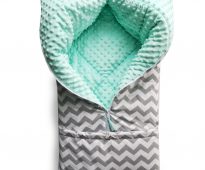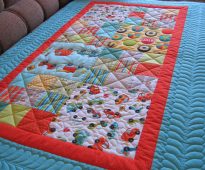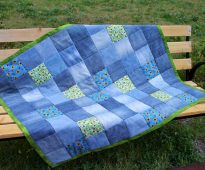 Blanket transformer for newborn
Blanket transformer for newborn
Hand-made textiles or sewing cloth napkins
We strive to create comfort in your home. Tablecloths, towels, napkins being an indispensable part of everyday life, additionally saturate the room with warmth and coziness. With the help of these interior elements, you can at any time transform the appearance of any room.
Every hostess knows that the atmosphere in the house is created from trifles.
The tablecloth on the table will allow you to fully experience the atmosphere of family warmth and home comfort. In this article we will explain how to sew napkins and tablecloths on the table with your own hands. Small household items, sewn with your own hands, will give a unique personality to the atmosphere of your home.
Ordinary napkins can transform the kitchen and turn the daily meal into a cozy family feast.
Content
Required materials for sewing
For tailoring textile elements with your own hands you need a good mood, desire and some improvised tools:
- Piece of cloth;
- Sewing machine;
- Basic sewing accessories: scissors, thread, measuring tape, pins, needles;
- Marking pencil;
- Ironing board and iron.
Napkins perform not only a decorative, but also a practical function.
Doing custom decor items: stages of work
Selection of matter
The crucial moment before making napkins or a tablecloth made of cloth with your own hands, is the selection of cloth for sewing. It is necessary to treat the choice with special responsibility, the appearance of the models, their practicality in operation will depend on it.
Sew them yourself is extremely simple.
Important! Fabrics selected for sewing should have sufficient density and weight. In this case, the things you have sewn will not slide on the table top or on the knees.
The material for the manufacture of napkins should be dense, but light, easy to wash and keep the original shape.
Cotton napkins are best for everyday use.
Napkins and tablecloths can be sewn with your own hands from different fabrics. Textile tablecloths and napkins can be made using both natural and synthetic fabrics, combining linen, lace, organza, satin. Combining opposites, you will understand how beautifully you can sew linen napkins with the use of organza patches and satin.
Napkins made from natural fabrics are not easily soiled and retain their shape quite well.
Natural fabrics (thick cotton, linen)
Practical, have sufficient density and weight. Excellent moisture absorption. The material is practical and wear-resistant, well ironed.
The variant from flax and sateen looks more festive.
Traditionally, for sewing table linen using cotton, flax and satin.
Natural linen mixed with synthetic yarn
The most common synthetic additive is polyester.Models made from blended materials are more practical in operation, less susceptible to shrinkage. Even the most problematic spots are easily removed from their surface.
The choice of colors depends solely on your desire.
Important! Things made from blended fabrics should not be subjected to high-temperature processing.
Synthetic material
These are 100% polyester webs. Suitable for sewing tablecloths, but it is not advisable to use for making homemade napkins. The fabric is practically not able to absorb moisture. Napkin made of synthetics will be difficult to use. She will not remove the moisture from the table, it is difficult to wipe her hands.
Napkins should be in harmony with the tablecloth and the general decoration of the room both in color and in texture.
Harmony means not only full color matching, but also a good contrast or mix.
Important! It is impossible to carry out washing in the temperature condition exceeding 40 degrees.
Stylish napkins look on the table sewn with your own hands from a fabric similar to the tablecloth table cloth.
It is easy enough to choose a shade of napkins, if you pick them up under the tablecloth.
How to calculate the consumption of matter
The consumption of material on the tablecloth
Consumption depends on the length of the table top, its width and the desired length of the overhang. Standard length of an overhang: 25-45 cm., Or lays down in a floor.
It is necessary to take into account the density of the material.
The longer the overhang, the more beautiful the model looks, but the tablecloth with a long overhang is not practical for everyday use. For everyday use, practical models with an overhang length not exceeding 25 cm.
Cotton fabrics before cutting should be washed, as they give a strong shrinkage.
Important! When calculating the length of the overhang, consider the percentage of shrinkage of the material. We advise before opening to wash and iron the canvas.
Material consumption for napkins
Initially decide on the desired size. The most convenient size is 50x50 cm. In this variant, the size of the workpiece should be 58x58 cm.
Use only sharp scissors for cutting material. Otherwise, the edges of the fabric will begin to crumble, and the cut will turn out uneven.
Cutting
Before cutting the iron material. Fold it on a flat surface, using a pencil and a ruler, make marks on its surface. We make the marks in a light line, on which we then cut off the extra patches. Special patterns for rectangular or square models are not needed.
The finished napkin can be ironed and starched.
Important! The cuts must be completely flat. Use sharp scissors. Otherwise, the edges will crumble, making it difficult to further processing.
Workpiece processing
How beautiful and stylish hem tablecloth? In this process, the main stage - processing angles. We will teach you how to sew corners on tablecloths and napkins. How to gently and quickly hem a tablecloth or napkins area? To do this, follow these steps.
Corners should look spectacular from both the front and back sides.
- We place the blank up on the wrong side, make a bend on the wrong side. The bend should be 1 cm. Fix the fold with pins. If uncomfortable with pins, you can baste. Iron iron lengthwise.
- On both sides of the corner, we define segments in the double value of the planned width of the hem. Then we connect both marks using a ruler and a pencil.
- We fold the material in the corner so that the marks made coincide. Fasten with pins place bend. We scribble on the typewriter on the made marking area.
- We cut off the surplus, leaving an allowance of no more than 5 mm. We turn out the stitched corner and iron it with an iron.
This wonderful elegant napkin is easy to do with your own hands.
By the same method, as indicated above, it is necessary to consistently process all corners of the tablecloth.
This kind of needlework is very popular lately.
Hemming
We told how to quickly make a beautiful corner on a napkin or tablecloth. After processing the four corners, the question arises how to process the edges of the napkin or tablecloth from the selected fabric. We spread the cloth tablecloth on the working surface up the wrong side. We do bends on a seamy side. Fasten them with pins or sweep them away, then press them. We spread the bends along the entire length on a typewriter. If desired, the sides can be treated with a special secret stitch.
Processing each edge of the napkin is similar.
Dressing models
Tablecloths and napkins can be sewn from thick natural linen with the addition of light lace inserts with flowers along the entire perimeter. A good addition to the models will be embroidery or applique.
On sale you can find many accessories for napkins.
The model with the addition of organza is luxurious, it will beautifully decorate the table in the dining room, it will be an appropriate addition to a romantic dinner.
When choosing a cloth for napkins, use the pieces of cloth left over from the manufacture of other products, for example, after making tablecloths.
We will show you how to quickly sew a tablecloth from organza or decorate napkins served on a festive table with it.
To make such napkins do-it-yourself even by young beginner needlewomen.
Organza inserts are usually sewn into the center of the tablecloth or they decorate the corners of the overhang. Drawing with flowers from organza will perfectly complement festive textiles.
Most valued do-it-yourself wipes.
VIDEO: How to sew beautiful napkins from flax.
50 original options of fabric napkins:
 Blanket transformer for newborn
Blanket transformer for newborn
 How to quilt a blanket
How to quilt a blanket
 Patchwork veil of old jeans: do it yourself
Patchwork veil of old jeans: do it yourself






